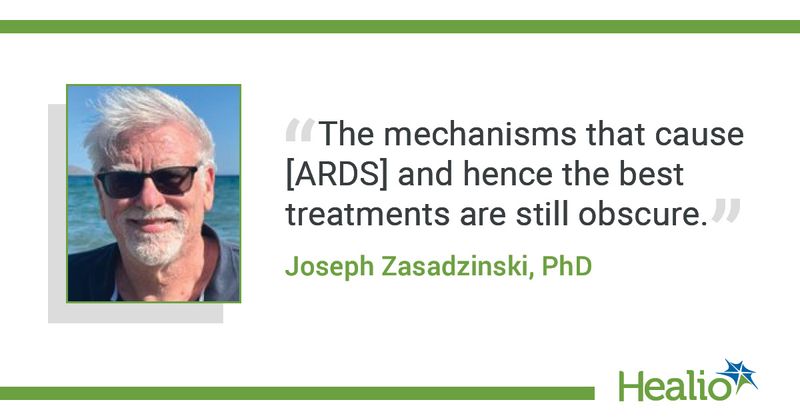Q&A: Uncovering why people develop acute respiratory distress syndrome
Click Here to Manage Email Alerts
Key takeaways:
- Researchers observed high lysolipid levels in those with acute respiratory distress syndrome (ARDS), which may lead to the condition.
- More research is needed on ARDS to find the best treatments.
The reason behind acute respiratory distress syndrome development in some patients suffering with severe respiratory illness and not others is unknown, but recent research suggests a possible explanation.
Many investigations have shown high levels of a lysolipid in those with ARDS. Researchers of this study, led by Joseph Zasadzinski, PhD, professor in the department of chemical engineering and materials science at the University of Minnesota, found that more lysolipids, or the “byproduct of the immune response to viruses and bacteria,” can lead to uneven lung inflation that evolves into respiratory distress, according to a university press release.

Healio spoke with Zasadzinski to learn more about lysolipid production, how lysolipids lead to ARDS and the importance of studying ARDS in today’s world.
Healio: Could you provide some detail about how diseases such as COVID-19 and pneumonia produce lysolipids?
Zasadzinski: During trauma or disease, the innate immune system produces lipases, in particular phospholipase A2, which cleaves double chain phospholipids in the cell membranes of bacteria and viruses into a fatty acid and the associated lysolipid. The higher solubility of the lysolipids relative to membrane phospholipids permeabilizes the viral or bacterial membrane, causing lysis of the pathogen. In the process, the overall concentration of lysolipid in the alveolar fluids increases, which is what we think leads to the problem.
Healio: Could you provide some detail about how lysolipids affect the surfactant and lead to respiratory distress and ARDS?
Zasadzinski: Lysolipids do two negative things. The first is that the lysolipids can act like a detergent and help solubilize lung surfactant lipids into micelles, thereby decreasing the coverage of the lung surfactant lipids at the interface, which increases the surface tension.
The second thing is that the lysolipids are not very good at regulating the surface tension. In order for the lung to inflate uniformly, the surface tension must decrease as we breathe out and increase as we breathe in. Lysolipids cannot do this very well compared with lung surfactant phospholipids. This causes problems with lung compliance and atelectasis and can lead to uneven inflation.
Healio: Are the same mechanics true in pediatric patients with ARDS?
Zasadzinski: We think so. Meconium and other things that lead to ARDS in pediatric patients contain relatively high concentrations of lipases and lysolipids. This can lead to trauma, which then might trigger the innate immune system and the production of more lipases and lysolipids. This triggers a negative cycle that can results in ARDS.
Healio: If lysolipids eliminate the surfactant, are any treatments available to replace it?
Zasadzinski: Replacement surfactants given to premature infants might help somewhat but would not address the underlying causes. The idea might be to try to adsorb the lysolipids into phospholipid vesicles and liposomes, inhibit the lipases to prevent the production of lysolipids and add new lung surfactants to try to replace any removed during this process. This is what we plan to work on next.
Healio: Has the prevalence of ARDS gone down since the decline of COVID-19? What other respiratory illnesses may lead to ARDS?
Zasadzinski: ARDS occurred at levels of approximately 150,000 cases per year in the U.S. prior to the pandemic and were due to lung trauma due to accidents, smoke inhalation, chemical inhalation, etc, as well as pneumonia and other lung diseases. ARDS increased with severe COVID-19 infections due to the involvement of the lungs with the disease, and some people believe that the type II cell, where surfactant is generated and stored in the alveolar epithelial tissue, was particularly targeted by the COVID-19 virus, leading to a decrease in surfactant production.
ARDS has decreased as the levels of severe COVID-19 infections has decreased, although I do not have any data on if it is back to pre-pandemic levels.
Healio: Why is it important to keep researching ARDS in today’s world and in the future?
Zasadzinski: ARDS is 40% to 50% fatal and the mechanisms that cause it and hence the best treatments are still obscure. We also have a basic lack of understanding of how surface tension, surfactants and lung mechanics are related at a fundamental level.
For more information:
Joseph Zasadzinski, PhD, can be reached at zasad008@umn.edu.
References:
- Ciutara CO, et al. Proc Natl Acad Sci U S A. 2023;doi:10.1073/pnas.2309900120.
- New insights into deadly acute respiratory distress syndrome. https://twin-cities.umn.edu/news-events/new-insights-deadly-acute-respiratory-distress-syndrome. Published March 13, 2024. Accessed March 14, 2024.
- Study provides new insights into deadly acute respiratory distress syndrome. https://www.eurekalert.org/news-releases/1037226. Published March 12, 2024. Accessed March 14, 2024.
